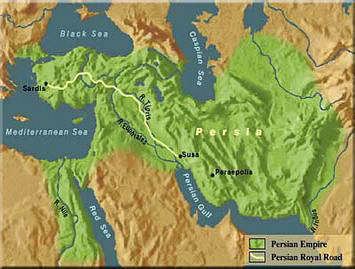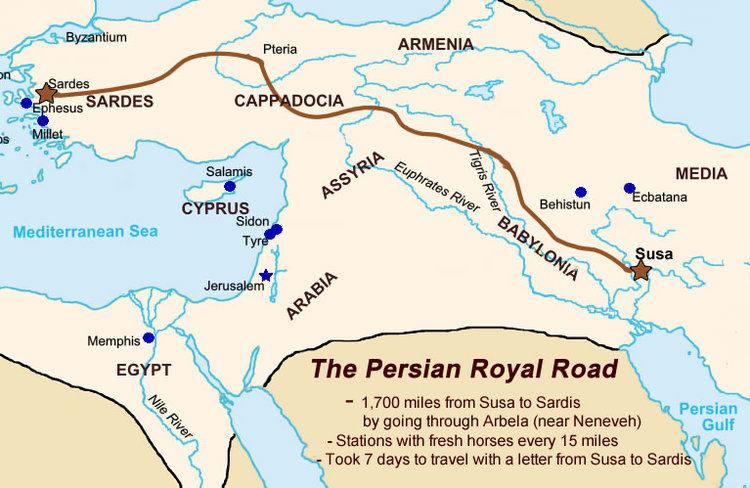 | ||
Similar Persian Corridor, Inca road system, El Camino Real (California) | ||
Drive along highway 67 from cape royal road to north rim lodge
The Royal Road was an ancient highway reorganized and rebuilt by the Persian king Darius the Great (Darius I) of the first (Achaemenid) Persian Empire in the 5th century BCE. Darius built the road to facilitate rapid communication throughout his very large empire from Susa to Sardis ("centralized rule is the victim of time and distance," Robin Lane Fox has observed in this context). Mounted couriers of the Angarium could travel 1677 miles (2699 km) in seven days; the journey from Susa to Sardis took ninety days on foot. The Greek historian Herodotus wrote, "There is nothing in the world that travels faster than these Persian couriers." Herodotus's praise for these messengers—"Neither snow nor rain nor heat nor gloom of night stays these couriers from the swift completion of their appointed rounds"— was inscribed on the James Farley Post Office in New York and is sometimes thought of as the United States Postal Service creed.
Contents
- Drive along highway 67 from cape royal road to north rim lodge
- Cape royal road north rim grand canyon
- Course of the Royal Road
- History of the Royal Road
- A metaphorical Royal Road in famous quotations
- References
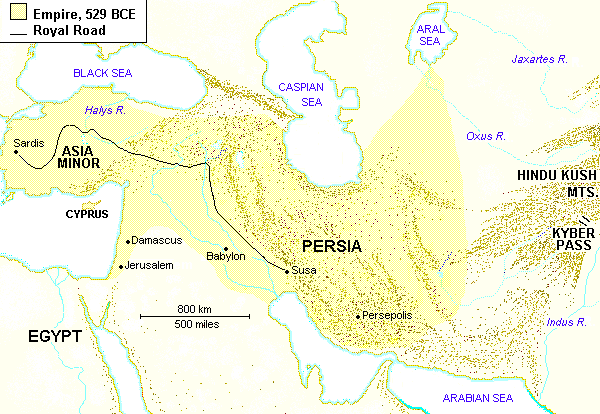
Cape royal road north rim grand canyon
Course of the Royal Road
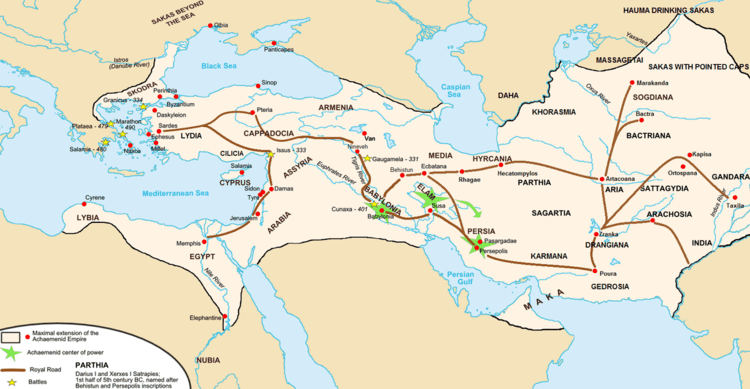
The course of the road has been reconstructed from the writings of Herodotus, archeological research, and other historical records. It began in Asia Minor (on the Aegean coast of Lydia, about 60 miles east of İzmir in present-day Turkey), traveled east through what is now the middle northern section of Turkey, (crossing the Halys according to Herodotus) and passed through the Cilician Gates to the old Assyrian capital Nineveh (present-day Mosul, Iraq), then turned south to Babylon (near present-day Baghdad, Iraq). From near Babylon, it is believed to have split into two routes, one traveling northeast then east through Ecbatana and on along the Silk Road, the other continuing east through the future Persian capital Susa (in present-day Iran) and then southeast to Persepolis. Of course, such long routes for travellers and tradesmen would often take months on end, and during the reign of Darius the Great numerous royal outposts (Caravanserai) were built.
History of the Royal Road
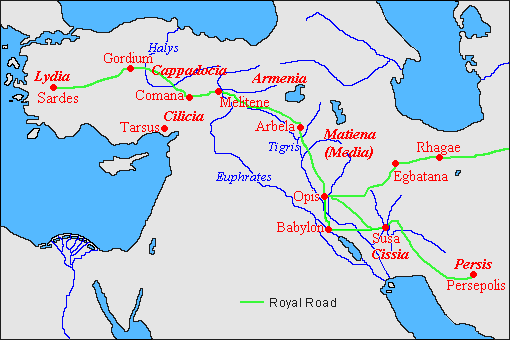
Because the road did not follow the shortest nor the easiest route between the important cities of the Persian Empire, archeologists believe the westernmost sections of the road may have originally been built by the Assyrian kings, as the road plunges through the heart of their old empire. More eastern segments of the road, identifiable in present-day northern Iran, were not noted by Herodotus, whose view of Persia was that of an Ionian Greek in the West; stretches of the Royal Road across the central plateau of Iran are coincident with the major trade route known as the Silk Road. This route was used by couriers to deliver messages to the Persian capital.
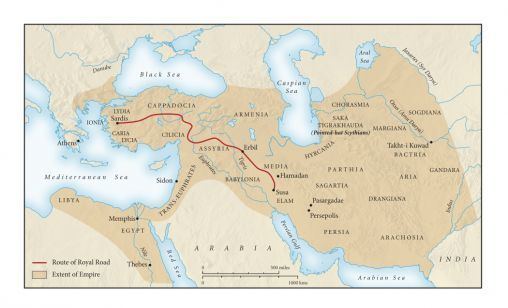
However, Darius I improved the existing road network into the Royal Road as it is recognized today. A later improvement by the Romans of a road bed with a hard-packed gravelled surface of 6.25 m width held within a stone curbing was found in a stretch near Gordium and connecting the parts together in a unified whole stretching some 1677 miles, primarily as a post road, with a hundred and eleven posting stations maintained with a supply of fresh horses, a quick mode of communication using relays of swift mounted messengers, the kingdom's pirradazis.
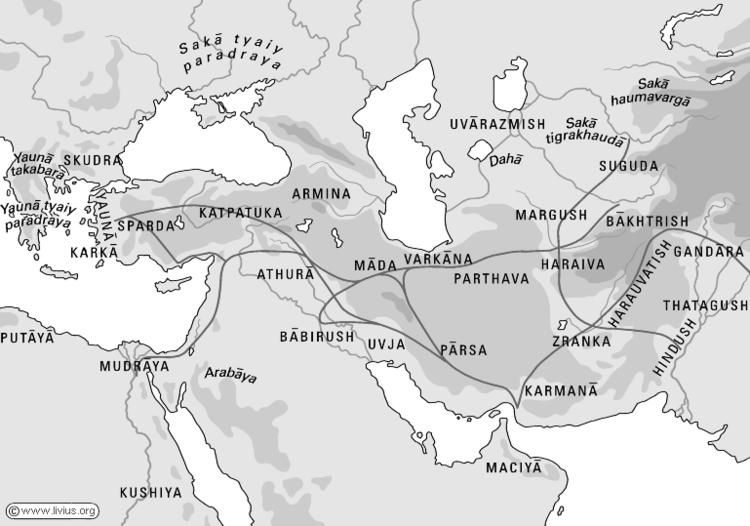
The road enhancements made by Darius were of such high quality that the road remained in use up until the Roman era. A bridge in Diyarbakır, Turkey, that dates back to this time is still standing, attesting to the road's durability and significance. Additionally, the road facilitated the expansion of long-distance trade for Persia, reaching its zenith during the reign of Alexander the Great (Alexander III of Macedon).

In 1961, under a grant from the American Philosophical Society, S. F. Starr traced the stretch of road from Gordium to Sardis, identifying river crossings by ancient bridge abutments.
A metaphorical “Royal Road” in famous quotations

Euclid is said to have replied to King Ptolemy's request for an easier way of learning mathematics that "there is no Royal Road to geometry," according to Proclus.

Charles Sanders Peirce, in his How to Make Our Ideas Clear (1878), says, "There is no royal road to logic, and really valuable ideas can only be had at the price of close attention." This essay was claimed by William James as instrumental in the foundation of the philosophical school of pragmatism.
Sigmund Freud famously described dreams as the "royal road to the unconscious" ("Via regia zur Kenntnis des Unbewußten").
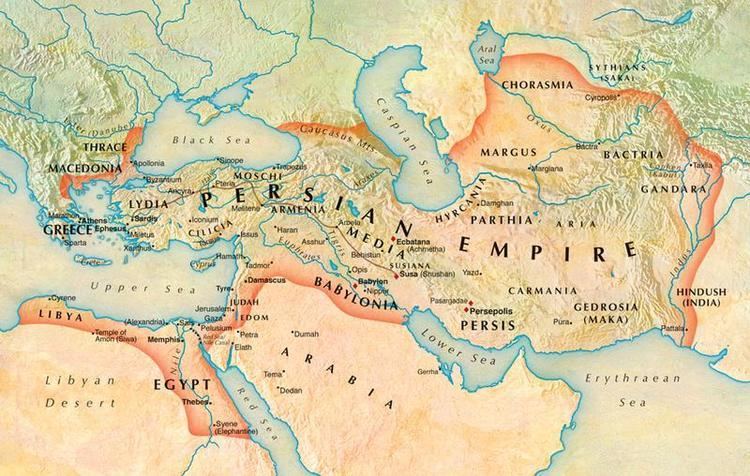
Karl Marx wrote in the 1872 Preface to the French Edition of Das Kapital (Volume 1), "There is no royal road to science, and only those who do not dread the fatiguing climb of its steep paths have a chance of gaining its luminous summits."
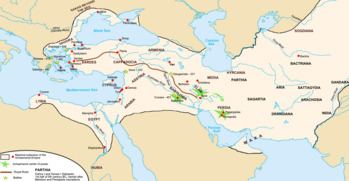
The Royal Road to Romance (1925) is the first book by Richard Halliburton, covering his world travels as a young man from Andorra to Angkor.
